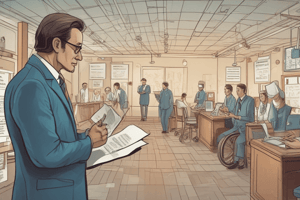Podcast
Questions and Answers
What does the process of organizing in an organization primarily involve?
What does the process of organizing in an organization primarily involve?
- Developing staffing patterns, creating a chain of command, and defining values
- Identifying work, creating policies, and implementing procedures
- Coordinating work, dividing labor, and assigning authority (correct)
- Formulating a mission, developing job descriptions, and establishing a vision
What is the main purpose of a mission statement for an organization?
What is the main purpose of a mission statement for an organization?
- To identify the organization's reason for existence and its target clients (correct)
- To reflect the organizational values and vision
- To outline the organization's future goals and aspirations
- To serve as a guideline for managerial decision-making
How do policies serve an organization?
How do policies serve an organization?
- They constrain individual behavior without offering context
- They establish broad guidelines for managerial decisions (correct)
- They dictate the organizational structure and staffing patterns
- They provide specific instructions for carrying out tasks
What does a vision statement outline for an organization?
What does a vision statement outline for an organization?
Which of the following best describes procedures within an organization?
Which of the following best describes procedures within an organization?
What is a key characteristic of the organizational philosophy?
What is a key characteristic of the organizational philosophy?
Which of the following elements form the foundation of an organization's structure in healthcare?
Which of the following elements form the foundation of an organization's structure in healthcare?
What role do the chain of command and authority play in organizing?
What role do the chain of command and authority play in organizing?
What is a major weakness of a matrix structure in an organization?
What is a major weakness of a matrix structure in an organization?
What type of planning primarily deals with the long-term goals of an organization?
What type of planning primarily deals with the long-term goals of an organization?
How does contingency planning function within an organization?
How does contingency planning function within an organization?
Which of the following best describes the vision of an organization?
Which of the following best describes the vision of an organization?
What is primarily determined by the mission of an organization?
What is primarily determined by the mission of an organization?
What key skills are essential for leaders operating within a matrix structure?
What key skills are essential for leaders operating within a matrix structure?
What is the primary purpose of established procedures in an organization?
What is the primary purpose of established procedures in an organization?
Which planning type focuses on specific department activities?
Which planning type focuses on specific department activities?
Which of the following describes the function of rules in an organization?
Which of the following describes the function of rules in an organization?
Which of the following is NOT part of the planning process outlined in the content?
Which of the following is NOT part of the planning process outlined in the content?
What is depicted in an organizational structure?
What is depicted in an organizational structure?
What does span of control refer to in an organizational context?
What does span of control refer to in an organizational context?
In a functional structure, how are employees typically grouped?
In a functional structure, how are employees typically grouped?
What is a characteristic of service-line structures in healthcare organizations?
What is a characteristic of service-line structures in healthcare organizations?
What is a drawback of having a centralized authority in an organization?
What is a drawback of having a centralized authority in an organization?
Which of the following is NOT a typical reason for employing established procedures?
Which of the following is NOT a typical reason for employing established procedures?
What is the primary purpose of policies in organizational planning?
What is the primary purpose of policies in organizational planning?
How do objectives differ from goals in a management context?
How do objectives differ from goals in a management context?
What type of budget is designed to be flexible and based on actual costs incurred?
What type of budget is designed to be flexible and based on actual costs incurred?
Which of the following best defines procedures in a management context?
Which of the following best defines procedures in a management context?
In the context of management, what does staffing involve?
In the context of management, what does staffing involve?
What distinguishes financial budgets from operating budgets?
What distinguishes financial budgets from operating budgets?
Which aspect of the management process involves grouping activities to meet goals?
Which aspect of the management process involves grouping activities to meet goals?
What type of budget begins from a 'zero base' and requires justifying all expenses?
What type of budget begins from a 'zero base' and requires justifying all expenses?
What is primarily emphasized in the managerial role?
What is primarily emphasized in the managerial role?
Shared leadership is primarily based on which of the following principles?
Shared leadership is primarily based on which of the following principles?
Which competency is essential for all nurse managers regardless of their title?
Which competency is essential for all nurse managers regardless of their title?
Which of the following best describes the role of a first-line manager?
Which of the following best describes the role of a first-line manager?
Why is shared leadership becoming more valued in organizations?
Why is shared leadership becoming more valued in organizations?
What is one function that managers do NOT focus on?
What is one function that managers do NOT focus on?
What leadership style is considered the most effective?
What leadership style is considered the most effective?
Which level of manager is responsible for strategic decision making in a healthcare organization?
Which level of manager is responsible for strategic decision making in a healthcare organization?
Flashcards are hidden until you start studying
Study Notes
Organizing
- Involves: Identifying work, dividing labor, developing chain of command and assigning authority
- In healthcare, mission, organizational structure, delivery systems, job descriptions, skill mix and staffing patterns form the basis
Philosophy
- Defines organizational values, vision and mission
- Written statement reflecting beliefs and values
- Nursing service philosophy should focus on holistic care, education and research
Vision
- Describes future state of the organization
- Aspirations of leaders drive the vision
- Should keep stakeholders focused on goals and the future
Mission
- Brief statement identifying the organization’s reasons for existing
- Highest priority in planning hierarchy
- Influences development of philosophy, goals, objectives, policies, procedures and rules
Policies
- Broad guidelines for managerial decisions
- Serve as basis for future actions and decisions
- Direct individual behavior towards the organization’s mission
Procedures
- Specific directions for implementing written policies
- Establish customary/acceptable ways to accomplish tasks
- Delineate sequence of steps required for action
Rules
- Define specific actions or non-actions
- Describe situations that allow only one choice of action
- Fewer rules is better
Organizational Structure
- Depicts formal organizational relationships
- Areas of responsibilities
- Person to whom one is accountable
- Channels of communication
Span of Control
- Number of direct reports a supervisor has
- Complex organizations have many highly specialized departments and a tall organizational structure with small differentiated work groups
- Supervisor should be able to effectively manage the group based on numbers, functions and geography
Functional Structures
- Employees grouped in departments by:
- Specialty
- Similar tasks performed by trained individuals
- Reporting to the same manager
- Centralized decision making
- Coordination between and among other functional areas may be limited
Service-line Structures
- Most common structure in healthcare
- Designed for rapid response in a changing environment
- Coexists with functional structures
- Example: Oncology nurse may work in the oncology service line, but also have ties to the functional area of nursing
Matrix Structure
- Integrates service-line and functional structures
- Manager is responsible for both function and product line
- Major weakness is dual authority which can cause frustration and confusion
- Strong interpersonal skills are required from leaders to resolve conflict
- Example: Oncology clinic nurse manager may report to the VP of nursing and the VP of outpatient services.
Planning
- Addresses questions of what, why, where, when, how and by whom
- Determines organizational structure, staffing and budgets
- Evolves from mission, philosophy and goals
- Can be reactive to a crisis or proactive in anticipation of problems or opportunities
Types of Planning
- Strategic or long-range planning: Determines long-term objectives and policies to achieve them. Future-oriented. Done at the executive level.
- Short-range planning or operational planning: Pertains to specific departments. Deals with tactics and techniques to achieve organizational goals.
Planning Hierarchy: Terms
- Vision: Outlines future role and function.
- Mission: Reason for existing, target clients and services provided.
- Philosophy: Statement of beliefs and values that guide practice.
- Goals: General, broad action commitments.
- Objectives: Specific, concrete action commitments.
- Policies: Broad guidelines for managerial decisions.
- Procedures: Specific directions for implementing policies.
- Rules: Define specific actions or non-actions.
Classification of Planning
- Operating Budget (Annual): Expenses, revenue, profit.
- Financial Budget: Cash, capital expenditure, balance sheet.
- Incremental Budget: Manpower, operating.
- Zero Based Budget: Requires justification for all items.
- Fixed or Variable Budget: Dependent on volume.
Management Process
- Planning: Determining the most appropriate type of patient care delivery.
- Organizing: Grouping activities to meet unit goals.
- Staffing: Recruiting, interviewing, hiring, orienting, scheduling, staff development, employee socialization and team building.
- Directing: Understanding and using power and authority appropriately.
- Controlling: Evaluating performance and taking corrective action.
Manager
- Responsible and accountable for efficiently accomplishing organizational goals.
- Focuses on: Coordinating resources, planning, organizing, supervising, staffing, evaluating, negotiation and representation.
- Has authority, responsibility, accountability and power defined by the organization.
- Requires interpersonal skills.
Leadership Theories
- Most effective leadership style complements organizational environment, tasks and personal characteristics of those involved.
Shared Leadership
- Based on empowerment principles of participative and transformational leadership.
- Many individuals at various levels are responsible for organizational fate and performance.
- Reasons for valuing shared leadership: Reorganization, decentralization and increasing complexity of problem solving in healthcare.
Levels of Managers
- First-level Manager: First-line manager or unit manager.
- Middle-level Manager: Department Manager.
- Top-level Manager: Executive manager, Chief Nursing Officer, Vice President of Patient Care.
- All nurse managers must hold certain competencies.
Studying That Suits You
Use AI to generate personalized quizzes and flashcards to suit your learning preferences.




